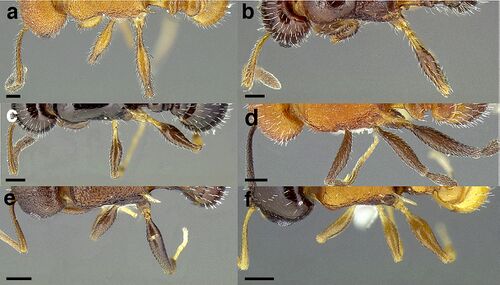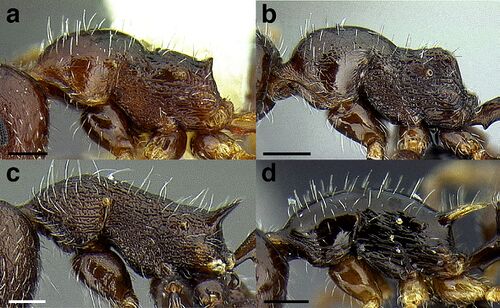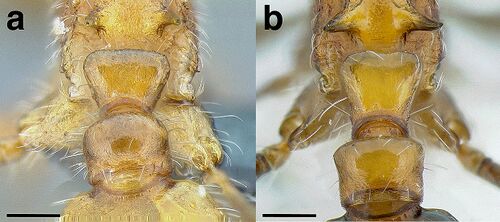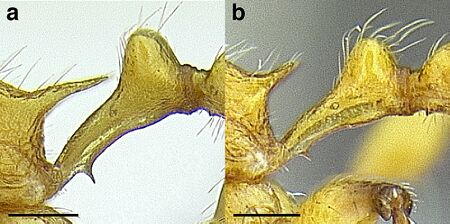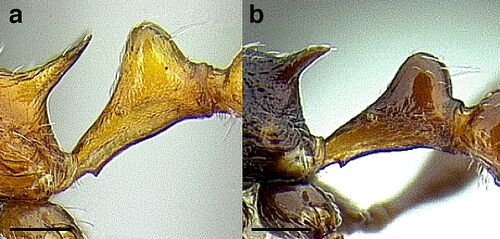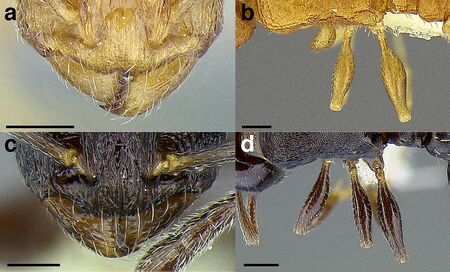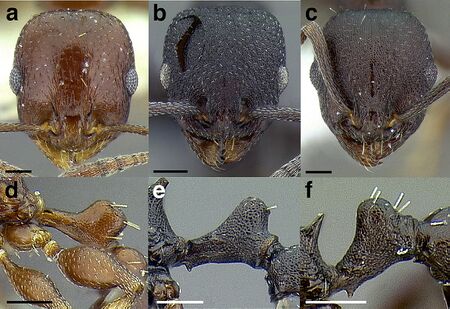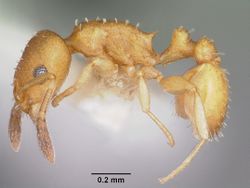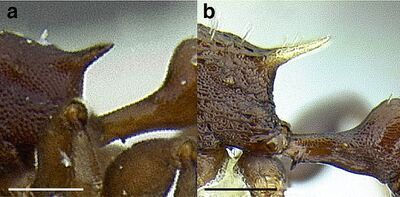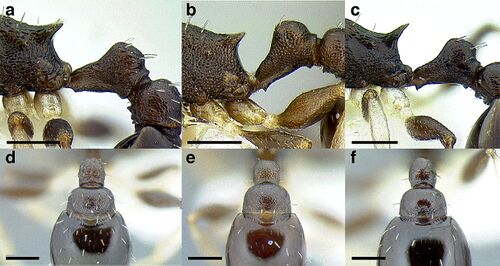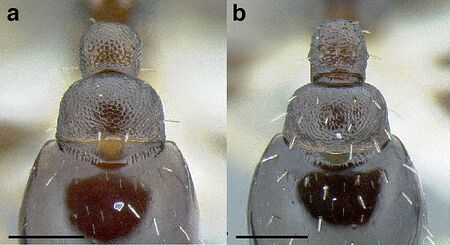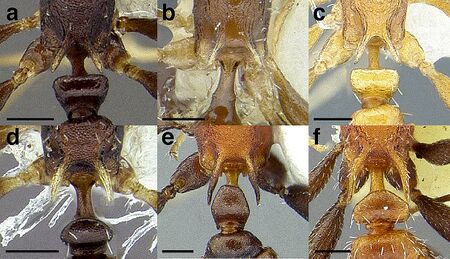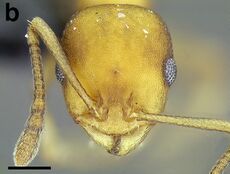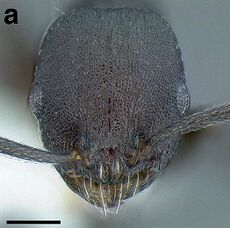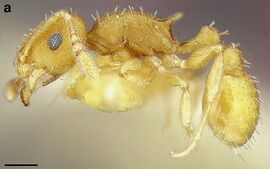Key to Temnothorax salvini clade workers
This worker key is based on: Prebus, M.M. 2021. Taxonomic revision of the Temnothorax salvini clade (Hymenoptera: Formicidae), with a key to the clades of New World Temnothorax. PeerJ. 9:e11514 462p. doi:10.7717/peerj.11514.
Key to species of the salvini clade based on the worker caste Two species, both described from Cuba, that are potentially members of the salvini clade were unable to be observed for this study. Therefore, Temnothorax cuyaguateje and Temnothorax imias are incertae sedis in Temnothorax.
You may also be interested in
1
- Body without standing setae of any kind, except on the clypeus and borders of the gastral sclerites; propodeum strongly depressed; propodeal spines long and down curved; petiolar node subquadrate; southern Texas to Nicaragua . . . . . Temnothorax misomoschus (misomoschus group)
- Body with standing setae: may be sparse, but at least present on the dorsum of the head, dorsum of the pronotum, and posterior margin of the postpetiole; other characters variable; widespread . . . . . 2
2
return to couplet #1
- Dorsal surfaces of legs and nearly all other surfaces of the body covered in long, tapering, suberect to subdecument setae (Figs. 37A–37C) . . . . . 3
- Dorsal surfaces of legs without long, tapering, suberect setae: long suberect setae, if present, are restricted to the ventral surface of the legs (Figs. 37D–37F) . . . . . 15
3
return to couplet #2
- In profile view, promesonotum forming a bulging, even convexity; metanotal groove impressed; propodeum strongly depressed below the level of the promesonotum (Figs. 38A & 38B); ground- or litter-nesting species; U.S.A. to Nicaragua (pergandei group) . . . . . 4
- In profile view, promesonotum grading evenly into propodeum, not bulging; metanotal groove often obscure; propodeum not strongly depressed (Figs. 38C & 38D); nesting habitat variable . . . . . 5
4
return to couplet #3
- Propodeal teeth present (see previous couplet Fig. 38A); North America, north of the Isthmus of Tehuantepec . . . . . Temnothorax pergandei (pergandei group)
- Propodeal teeth absent (see previous couplet Fig. 38B); propodeal angles rounded and marked by a carina; Central America, south of the Isthmus of Tehuantepec . . . . . Temnothorax bison (pergandei group)
5
return to couplet #3
- Mesosoma strongly arched in profile view (Figs. 39A & 39B) . . . . . 6
- Mesosoma not strongly arched in profile view: flat to slightly sinuate (Figs. 39C & 39D); arboreally-nesting species in Central America from Southern Mexico to Panama (salvini group, in part) . . . . . 7
6
return to couplet #5
- Dorsum of head above compound eyes and dorsum of mesosoma smooth and shining (see previous couplet Figs. 39A & 39E); integument predominantly dark brown to black; nesting in hollow twigs in the leaf litter, in dead branches, or under bark near the ground on live trees; Sonoran Desert . . . . . Temnothorax politus (subditivus group, part)
- Dorsum of head above compound eyes and dorsum of mesosoma areolate, with overlying rugose sculpture (see previous couplet Figs. 39B & 39F); integument predominantly yellow to testaceous; nesting habitat unknown, collected from leaf litter extractions; Southern Mexico to Honduras (salvini group, in part) . . . . . Temnothorax terraztecus (salvini group, part)
7
return to couplet #5
- Petiolar node strongly squamiform, broadly expanded apically: PNWI ≥ 160, corners distinctly angulate in posterior view (Fig. 40A) . . . . . 8
- Petiolar node not as strongly squamiform, not as broadly expanded apically: PNWI ≤150, corners rounded in posterior view (Fig. 40B) . . . . . 11
8
return to couplet #7
- Light yellow to color orange, subpetiolar tooth acutely spiniform (Fig. 41A) . . . . . 9
- Color dark brown, subpetiolar tooth minute and triangular (Fig. 41B) . . . . . Temnothorax longicaulis (salvini group, part)
9
return to couplet #8
- Dorsum of head with strongly rugose sculpture overlying areolate sculpture; subpetiolar tooth shorter than the setae that arises from the peduncle directly above it (Fig. 42A; may be decumbent in some specimens); dorsum of petiolar node and postpetiole lightly sculptured; size larger: WL> 1.25 mm . . . . . Temnothorax aztecoides (salvini group, part)
- Dorsum of head with weaker, costate-rugose sculpture overlying areolate sculpture; subpetiolar tooth longer: equal to or longer than the setae that arise from the peduncle directly above it (Fig. 42B; may be decumbent in some specimens); dorsum of petiolar node and postpetiole smooth and shining to very weakly areolate-rugulose; size smaller: WL <1.17 mm . . . . . 10
10
return to couplet #9
- Propodeal spines longer than the propodeal declivity: PSI> 32 (Fig. 43A) . . . . . Temnothorax aztecus (salvini group, part)
- Propodeal spines shorter than the propodeal declivity: PSI <30 (Fig. 43B) . . . . . Temnothorax paraztecus (salvini group, part)
11
return to couplet #7
- Subpetiolar tooth equal to or longer than the setae that arises from the peduncle directly above it (Fig. 44A; may be decumbent in some specimens) . . . . . Temnothorax longinoi (salvini group, part)
- Subpetiolar tooth shorter than the setae that arises from the peduncle directly above it (Fig. 44B; may be decumbent in some specimens) . . . . . 12
12
return to couplet #11
- Propodeal spines long: PSI> 30 (Fig. 45A) . . . . . Temnothorax quetzal (salvini group, part)
- Propodeal spines shorter: PSI <30 (Fig. 45B) . . . . . 13
13
return to couplet #12
- Petiolar node not expanded apically: PNWI ≤ 130 (Fig. 46A) . . . . . Temnothorax salvini (salvini group, part)
- Petiolar node expanded apically: PNWI ≥ 160 (Fig. 46B) . . . . . 14
14
return to couplet #13
- Dorsum of mesosoma predominantly rugose; integument areolate between propodeal spines (Fig. 47A) . . . . . Temnothorax parvidentatus (salvini group, part)
- Dorsum of mesosoma predominantly costate; integument smooth and shining between propodeal spines (Fig. 47B) . . . . . Temnothorax fortispinosus (salvini group, part)
15
return to couplet #14
- Antennal scapes with suberect pilosity (Fig. 48A); postpetiole moderately broad, 2.1 to 2.2 times the width of the caudal cylinder of the petiole in dorsal view (PSI 210-220); anterior quarter of first gastral tergite very weakly areolate; integument light yellow; Baja California . . . . . Temnothorax pilicornis (pilicornis group)
- Antennal scapes with subdecumbent to adpressed pilosity (Fig. 48B); postpetiole narrow to very broad; if first gastral tergite sculptured and integument yellow, then petiole narrower: less than 2 times the width of the caudal cylinder in dorsal view (PSI <200); widespread . . . . . 16
16
return to couplet #15
- Petiolar node cuneiform to subcuneiform (Figs. 49A–49C) . . . . . 17
- Petiolar node shaped otherwise (Figs. 49D–49F) . . . . . 18
17
return to couplet #16
- Anterior clypeal margin emarginate; hind femora moderately to strongly incrassate (Figs. 50A & 50B); Southern U.S.A. and Northern Mexico (rugosus group, in part) . . . . . Temnothorax rugosus (rugosus group, part)
- Anterior clypeal margin entire; hind femora weakly incrassate (Figs. 50C & 50D); Southern Mexico (Chiapas) . . . . . Temnothorax acuminatus (acuminatus group, part)
18
return to couplet #16
- Petiole with a transverse carina anterodorsally (Figs. 51A & 51B); postpetiole narrow, <1.5 times as wide as the caudal cylinder of the petiole in dorsal view (PWI <150) (Figs. 51C & 51D); Mexico . . . . . 19
- Petiole with a transverse carina dorsally or not (Fig. 51E); postpetiole relatively broad, ≥ 1.5 times as wide as the caudal cylinder of the petiole in dorsal view (PWI ≥ 150) (Figs. 51F–51H); widespread . . . . . 20
19
return to couplet #18
- Anterior margin of clypeus entire (Fig. 52A); propodeum without many setae dorsally, except near extreme anterior near the metanotal groove and midway along the length of the propodeal spines (Fig. 52B); petiolar node dorsally rounded in profile view; first gastral sternite areolate-rugulose; Mexico (Veracruz) . . . . . Temnothorax tuxtlanus (acuminatus group, part)
- Anterior margin of clypeus emarginate (Fig. 52C); propodeum with at least one pair of setae dorsally (Fig. 52D); petiolar node dorsally truncate in profile view; first gastral sternite smooth; Mexico (Chihuahua; rugosus group, in part) . . . . . Temnothorax parralensis (rugosus group, part)
20
return to couplet #18
- With the following characters in combination: anterior margin of the clypeus strongly emarginate medially; petiolar peduncle short to moderately long, comprising half the length of the petiole or less; petiolar node subquadrate, erect, and relatively short: NI <170 (Fig. 53); arboreally-nesting species from Southwestern U.S.A. to South Central Mexico (annexus group) . . . . . 21
- Not having the above combination of characters; if clypeus is strongly emarginate, then petiolar peduncle is longer and/or petiolar node is not subquadrate; widespread . . . . . 25
21
return to couplet #20
- Erect setae present on gula (Fig. 54A) . . . . . 22
- Setae, if present on gula, not erect (Fig. 54B) . . . . . 24
22
return to couplet #21
- Head elongate: CI 80-84 (Fig. 55A) . . . . . Temnothorax balnearius (annexus group)
- Head less elongate: CI 86-90 (Figs. 55B & 55C) . . . . . 23
23
return to couplet #22
- Petiolar node lower, not as strongly quadrate in profile view; posterior margin of petiolar node indistinct in profile view, much shorter than dorsal margin (Fig. 56A); first gastral tergite densely areolate . . . . . Temnothorax obtusigaster (annexus group)
- Petiolar node high and strongly quadrate in profile view; posterior margin of petiolar node distinct in profile view, about two thirds as long as dorsal margin (Fig. 56B); first gastral tergite smooth and shining . . . . . Temnothorax arbustus (annexus group)
24
return to couplet #21
- Propodeal spines longer, broad; petiole pedunculate (Fig. 57A); body heavily sculptured: pronotum in profile view areolate with overlying rugose sculpture . . . . . Temnothorax annexus (annexus group)
- Propodeal spines shorter, less broad; peduncle of petiole shorter (Fig. 57B); body less heavily sculptured: pronotum in profile view predominantly areolate, without overlying rugose sculpture . . . . . Temnothorax quercicola (annexus group)
25
return to couplet #20
- Propodeal spines long (PSI ≥ 22), acute, and directed dorsally: forming an angle of 130 ° or greater with the propodeal declivity in profile view (Fig. 58a–58C) . . . . . 26
- Propodeal spines, if directed dorsally, not long (PSI ≤ 20; Fig. 58D–58F) . . . . . 28
26
return to couplet #25
- Dorsum of head weakly sculptured: smooth and shining between weak costulate sculpture; petiolar node erect and subquadrate (Figs. 59A & 59D); Southern Mexico . . . . . Temnothorax tenuisculptus (tenuisculptus group)
- Dorsum of head strongly sculptured: uniformly areolate-rugulose with overlying costulate or rugulose sculpture; petiolar node rounded dorsally (Figs. 59B, 59C, 59E, 59F); Southern Mexico to Honduras . . . . . 27
27
return to couplet #26
- Postpetiole relatively narrow: <1.7 times as wide as the caudal cylinder of the petiole in dorsal view (PWI <170; Fig. 60A); Southern Mexico to Honduras . . . . . Temnothorax acutispinosus (acutispinosus group)
- Postpetiole relatively broad: about 2 times as wide as the caudal cylinder of the petiole in dorsal view (PWI ~ 200; Fig. 60B); Honduras . . . . . Temnothorax altinodus (altinodus group)
28
return to couplet #25
- With the following characters in combination: dorsal surface of head uniformly areolate (Fig. 61A); petiolar peduncle moderately long, comprising less than half the petiolar length; petiolar node antero-posteriorly compressed and tall, with posterior face about as long as the anterior face in profile view (Fig. 61B); Texas and Northern Mexico . . . . . Temnothorax terrigena (terrigena group)
- Not matching the above description; if dorsal surface of head is uniformly areolate and petiolar peduncle is moderately long, then the petiolar node is not antero-posteriorly compressed and tall; widespread . . . . . 29
29
return to couplet #28
- Petiolar node tall and leaning posteriorly in profile view, overhanging the caudal cylinder of the petiole (Figs. 62A–62C); Mexico to Nicaragua (augusti group) . . . . . 30
- Petiolar node, if tall, not leaning posteriorly in profile view (Figs. 62D–62F); widespread . . . . . 33
30
return to couplet #29
- Propodeal spines short: PSI <35 (Fig. 63A) . . . . . Temnothorax augusti (augusti group)
- Propodeal spines longer: PSI> 35 (Fig. 63B) . . . . . 31
31
return to couplet #30
- Head relatively broad: CI ≥ 84 (Fig. 64A) . . . . . Temnothorax leucacanthoides (augusti group)
- Head relatively narrow: CI ≤ 81 (Fig. 64B) . . . . . 32
32
return to couplet #31
- Antennal scapes longer: SI> 100 . . . . . Temnothorax aureus (augusti group)
- Antennal scapes shorter: SI ≤ 100 . . . . . Temnothorax leucacanthus (augusti group)
33
return to couplet #29
- Antennal scapes long, exceeding the posterior margin of the head by about two times the maximum width of the scape when fully retracted (SI> 110); dorsum of mesosoma not strongly arched dorsally in profile view; propodeal spines shorter than the propodeal declivity (PSI <35); petiolar node subquadrate; Mexico (Puebla) . . . . . Temnothorax casanovai (casanovai group)
- Not matching the above description; if antennal scapes are long, mesosoma strongly arched dorsally, propodeal spines longer than the propodeal declivity, and petiolar node is squamiform; widespread . . . . . 34
34
return to couplet #33
- With the following character combination: propodeal spines short (PSI <30); in profile view, dorsum of petiolar node subquadrate to rounded, and bearing four to six erect setae (Figs. 65A–65C); in dorsal view, postpetiole moderately broad (190 <PWI <235; Figs. 65D–65F); Southern Mexico to Guatemala (goniops group, in part) . . . . . 35
- Not matching the above description; widespread . . . . . 37
35
return to couplet #34
- Dorsum of head and post-petiole predominantly smooth and shining (Figs. 66A & 66B) . . . . . Temnothorax xincai (goniops group, part)
- Dorsum of head and post-petiole areolate-rugulose (Figs. 66C & 66D) . . . . . 36
36
return to couplet #35
- Petiolar node expanded apically: PNWI> 120 (Fig. 67A) . . . . . Temnothorax ixili (goniops group, part)
- Petiolar node not expanded apically: PNWI <115 (Fig. 67B) . . . . . Temnothorax achii (goniops group, part)
37
return to couplet #34
- Petiolar node squamiform (Figs. 68A–68D) . . . . . 38
- Petiolar node not squamiform (Figs. 68E–68H) . . . . . 42
38
return to couplet #37
- In dorsal view, propodeal spines straight and evenly diverging: negative space between the propodeal spines “V” shaped, or a basally truncate “V” (Figs. 69A–69C); dorsum of petiolar node flat, sides evenly converging basally (Figs. 69A & 69C); widespread . . . . . Temnothorax subditivus (subditivus group, part)
- In dorsal view, propodeal spines diverging, but curved toward the midline of the body: negative space between the propodeal spines “U” shaped, or a basally truncate “U” (Figs. 69D–69F); dorsum of petiolar node rounded to flat, sides bowed (Figs. 69D–69F); Bahamas and Cuba (pastinifer group, in part) . . . . . 39
39
return to couplet #38
- Head predominantly smooth and shining (Fig. 70A) . . . . . Temnothorax schwarzi (pastinifer group, part)
- Head sculptured: areolate to areolate-rugulose with overlying rugulose sculpture (Figs. 70B–70F) . . . . . 40
40
return to couplet #39
- Anterior margin of clypeus strongly emarginated (Fig. 71A); in profile view, petiole strongly squamiform and overhanging the petiolar peduncle; petiole with only two erect setae dorsally, postpetiole with six or fewer (Fig. 71B) . . . . . Temnothorax pastinifer (pastinifer group, part)
- Anterior margin of clypeus entire or, if weakly indented, head and mesosoma with well-defined rugae in addition to areolae (Fig. 71C); in profile view, petiole strongly squamiform or not; petiole with four or more erect setae, postpetiole with ten or more (Fig. 71D) . . . . . 41
41
return to couplet #40
- Antennal scape long, surpassing posterior margin of head by> 2x the maximum width of the scape when fully retracted (SI ~ 106; Fig. 72A); petiolar node strongly enlarged apically (PNWI> 180; Fig. 72B) . . . . . Temnothorax rutabulafer (pastinifer group, part)
- Antennal scape short, barely surpassing the posterior margin of head when fully retracted (Fig. 72C); petiolar node weakly enlarged apically (PNWI <160; Fig. 72D) . . . . . Temnothorax androsanus (pastinifer group, part)
42
return to couplet #37
- With the following character combination: antennal scapes surpassing the posterior margin of the head capsule by about one and a half times their length; dorsum of mesosoma strongly arched; petiole with a moderately long peduncle; petiolar node high, strongly rounded dorsally, and wider than the caudal cylinder of the petiole in dorsal view; postpetiole wide (215 <PWI <240); bicolored species: head capsule dark, remainder of body light yellow; Cuba (pastinifer group, in part) . . . . . Temnothorax nigricans (pastinifer group]], part)
- Not matching the above description; widespread . . . . . 43
43
return to couplet #42
- Postpetiole moderately broad (150 <PWI <220; Figs. 73A–73D); Mexico to Costa Rica . . . . . 58
- Postpetiole very broad (PWI> 220; Figs. 73E–73H); Southern Florida, Bahamas, Greater Antilles, Northern Lesser Antilles (pulchellus group) . . . . . 44
44
return to couplet #43
- Hind femora strongly incrassate (FI> 370); propodeal spines short (PSI <21) and petiole with> 4 erect setae (Fig. 74A); Hispaniola . . . . . Temnothorax laticrus (pulchellus group)
- Hind femora not as strongly incrassate (FI <360); propodeal spines longer (PSI ≥ 30) and petiole with ≤ 4 erect setae (Fig. 74B); widespread, including Hispaniola . . . . . 45
45
return to couplet #44
- Erect setae on dorsum of mesosoma very sparse, restricted to a pair arising from the promesonotum (Figs. 75A & 75B) . . . . . 46
- Standing setae on dorsum of mesosoma more abundant, with erect setae on other regions of the mesosoma, in addition to the promesonotum (Figs. 75C & 75D) . . . . . 47
46
return to couplet #45
- Dorsum of head and mesosoma smooth and shining; dorsum of petiole with two erect setae; bicolored: head and gaster dark brown, remainder of body yellow; U.S. and British Virgin Islands . . . . . Temnothorax pulchellus (pulchellus group)
- Dorsum of head and mesosoma areolate; dorsum of petiole without erect setae; uniformly testaceous yellow; Barbuda . . . . . Temnothorax wettereri (pulchellus group)
47
return to couplet #45
- Petiole with only 2 erect setae (Figs. 76A –76C) . . . . . 48
- Petiole with 4 erect setae (Figs. 76D–76F) . . . . . 50
48
return to couplet #47
- Head predominantly smooth and shining, with weak costulate sculpture along the medial edges of the frontal carinae (Fig. 77A); Cuba . . . . . 49
- Head with stronger sculpture, either with a smooth central strip surrounded by weakly areolate and costulate sculpture, or with the head uniformly areolate (Figs. 77B & 77C); southern Florida, Bahamas, and Cuba . . . . . Temnothorax torrei (pulchellus group)
49
return to couplet #48
- In full-face view, posterior margin of head passing into the lateral margins through a broad curve, giving the head an ovular shape (Fig. 78A); in dorsal view, promesonotal suture deeply impressed and extending to the dorsal face of the mesosoma (Fig. 78B); in profile view, petiolar node subquadrate: dorsal face transitioning to posterior face through a rounded ~90 ° angle (Fig. 76C, see couplet #47) . . . . . Temnothorax hippolyta (pulchellus group)
- In full-face view, posterior margin of head passing into the lateral margins through a rounded angle, giving the head a boxy shape (Fig. 78C); in dorsal view, promesonotal suture not deeply impressed (Fig. 78D); in profile view, petiolar node not subquadrate: dorsal face transitioning to posterior face through broad curve (Fig. 76B) . . . . . Temnothorax terricola (pulchellus group)
50
return to couplet #47
- Dorsum of head uniformly areolate (Figs. 79A–79C) . . . . . 51
- Dorsum of head smooth and shining, or sculptured otherwise (Figs. 79D –79F) . . . . . 52
51
return to couplet #50
- In full-face view, head with posterior margin weakly concave (see previous couplet Figs. 79A & 79C) . . . . . Temnothorax agavicola (pulchellus group)
- In full-face view, head with posterior margin flat to convex (see previous couplet Fig. 79B) . . . . . Temnothorax albispinus (pulchellus group)
52
return to couplet #50
- Metapleural gland bulla large, extending more than halfway between the metacoxal insertion and the propodeal spiracle (Fig. 80A); U.S. Virgin Islands . . . . . Temnothorax magnabulla (pulchellus group)
- Metapleural gland bulla smaller, extending about halfway between the metacoxal insertion and the propodeal spiracle (Figs. 80B–80D); Hispaniola . . . . . 53
53
return to couplet #52
- Mesosoma smooth and shining dorsally (Figs. 81A & 81D); dorsum of mesosoma strongly convex in profile view (Figs. 81B & 81C) . . . . . 54
- Mesosoma areolate-rugulose dorsally (Figs. 81E & 81H); dorsum of mesosoma weakly convex in profile view (Figs. 81F & 81G) . . . . . 56
54
return to couplet #53
- Uniformly yellow . . . . . Temnothorax flavidulus (pulchellus group)
- Color variable, but never uniformly yellow . . . . . 55
55
return to couplet #54
- On anterior margin of clypeus, medial two pairs of setae about the same width (Fig. 82A); strikingly bicolored: head, mesosoma and waist segments dark brown; remainder bright yellow . . . . . Temnothorax harlequina (pulchellus group)
- On anterior margin of clypeus, pair of setae flanking the medial pair about twice the width of the medial pair (Fig. 82B); integument color variable, but if bicolored, gaster never uniformly bright yellow . . . . . Temnothorax ciferrii (pulchellus group)
56
return to couplet #53
- Anterior clypeal margin emarginated medially (Fig. 83A) . . . . . Temnothorax wilsoni (pulchellus group)
- Anterior clypeal margin flat to evenly convex (Fig. 83B) . . . . . 57
57
return to couplet #56
- Petiole long relative to the postpetiole (PLI 148–166; Fig. 84A) . . . . . Temnothorax balaclava (pulchellus group)
- Petiole short relative to the postpetiole (PLI 140–143; Fig. 84B) . . . . . Temnothorax bahoruco (pulchellus group)
58
return to couplet #43
- Petiolar node low, elongate (NI> 170; Figs. 85A & 85B); Mexico to Costa Rica (fuscatus group) . . . . . 59
- Petiolar node high, relatively short (NI <150; Fig. 85C & 85D); Southern Mexico and Guatemala (goniops group, in part) . . . . . 62
59
return to couplet #58
- Propodeal spines long: PSI> 22 (Figs. 86A & 86B); body uniformly colored . . . . . 60
- Propodeal spines short: PSI <19 (Fig. 86C); bicolored: either with mesosoma red and rest of body dark brown, or with gaster yellow and body dark brown . . . . . 61
60
return to couplet #59
- Propodeal spines acute (see previous couplet Fig. 86A) . . . . . Temnothorax fuscatus (fuscatus group)
- Propodeal spines truncate (see previous couplet Fig. 86B) . . . . . Temnothorax nebliselva (fuscatus group)
61
return to couplet #59
- Eye small and round: in profile view, distance between the compound eye and base of mandible greater than the maximum length of the eye, OI ≤ 22 (Fig. 87A); body predominantly dark brown, contrasting with a red mesosoma . . . . . Temnothorax ocarinae (fuscatus group)
Eye larger and oval: in profile view, distance between the compound eye and base of mandible roughly equal to the maximum length of the eye, OI ≥ 24 (Fig. 87B); body predominantly dark brown, with a contrasting bright yellow gaster . . . . . Temnothorax skwarrae (fuscatus group)
62
return to couplet #58
- Head sculptured: dorsum uniformly areolate-rugose (Fig. 88A) . . . . . Temnothorax goniops (goniops group, part)
- Dorsum of head predominantly smooth and shining (Fig. 88B) . . . . . Temnothorax huehuetenangoi (goniops group, part)


